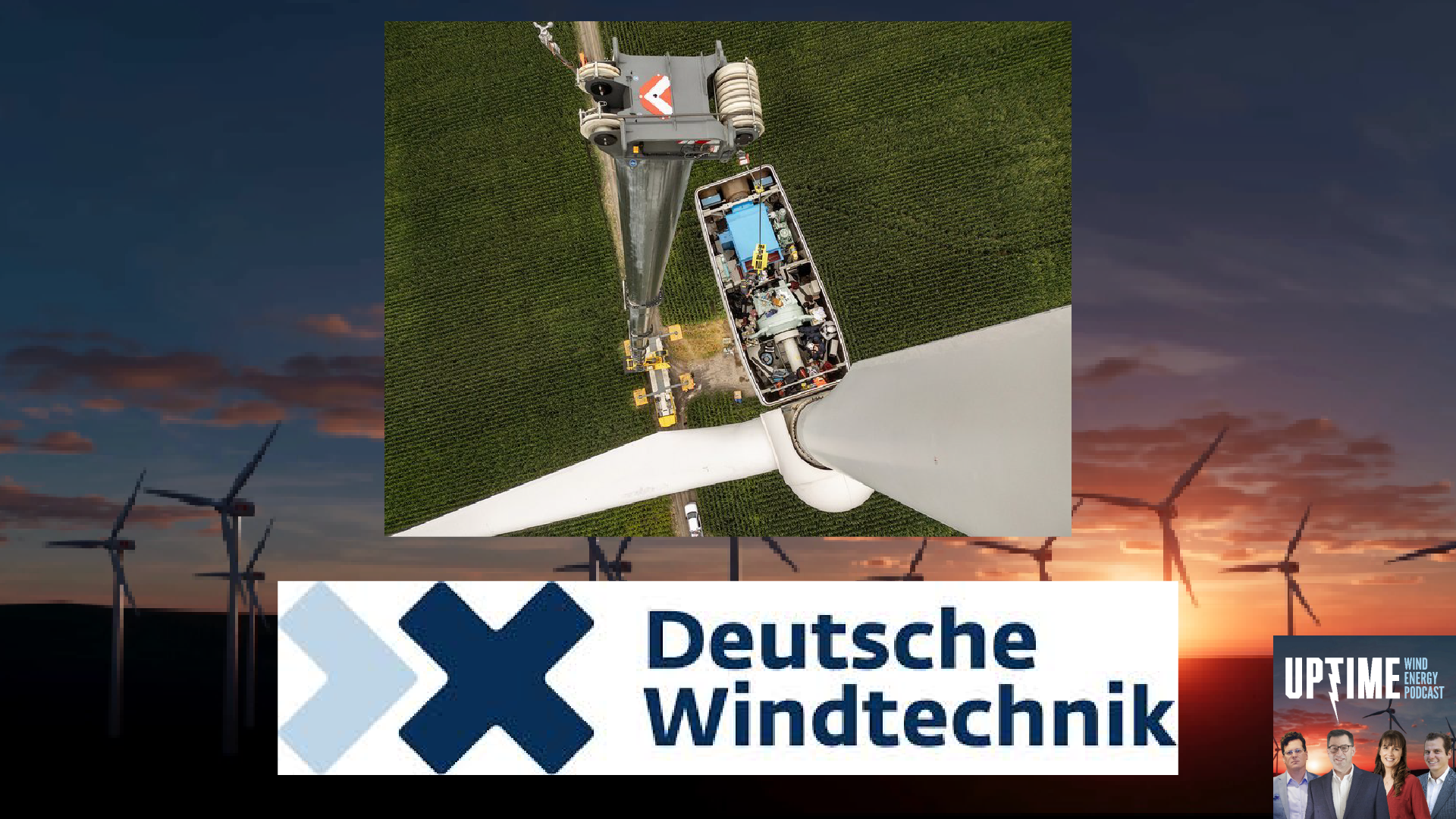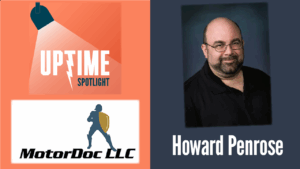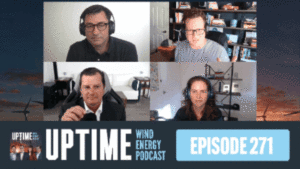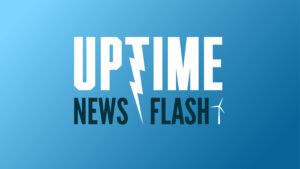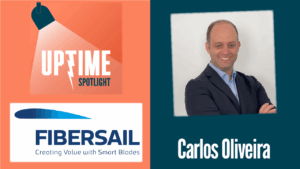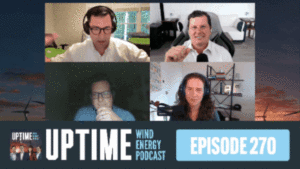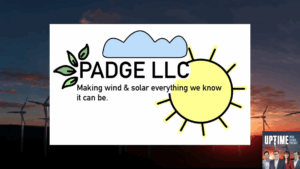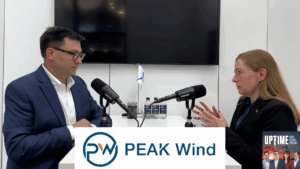Podcast: Play in new window | Download
Allen Hall and Joel Saxum speak with Tyler Gifford, Director of Repower at Deutsche Windtechnik, about the impact of the Inflation Reduction Act on wind turbine repowering. They explore the 80/20 rule, overcoming challenges, and optimizing older wind assets to improve reliability and efficiency.
Fill out our Uptime listener survey and enter to win an Uptime mug!
Sign up now for Uptime Tech News, our weekly email update on all things wind technology. This episode is sponsored by Weather Guard Lightning Tech. Learn more about Weather Guard’s StrikeTape Wind Turbine LPS retrofit. Follow the show on Facebook, YouTube, Twitter, Linkedin and visit Weather Guard on the web. And subscribe to Rosemary Barnes’ YouTube channel here. Have a question we can answer on the show? Email us!
Allen Hall: Welcome to the Uptime Wind Energy Podcast Spotlight. I’m your host, Allen Hall, along with my co-host Joel Saxum. Today we’re diving deep into one of the most significant developments in wind energy, the Inflation Reduction Act, and its impact on wind turbine repowering. Joining us is Tyler Gifford, director of Repower at Deutsche Windtechnik.
Tyler leads Repowering initiatives across nine wind energy facilities in five states, managing over one gigawatts. Of clean energy capacity. His hands-on experience with multiple turbine platforms and deep understanding of wind farm operations makes Tyler the perfect guest to discuss the complexities of wind turbine repowering under the IRA.
Welcome to Uptime Spotlight, shining light on wind energy’s brightest innovators. This is the progress powering tomorrow.
Allen Hall: Tyler, welcome to the show. Thanks for having me. Guys, there’s a bunch of questions that we want to ask you about the IRA bill and how Repowering is happening, but as we talk across the United States, there seems to be a lot of challenges there. What are some of those challenges that wind farms that are getting close to Repowering are facing?
As they start to make some of these decisions?
Tyler Gifford: Good question, Allen. I mean, typically with Repowering, a lot of people think of, I’m gonna tear the tower down and I’m gonna start fresh and I’m gonna put a whole new one up. So what we think about is there’s another approach to this, the 80 20 and the IRA has really introduced a new opportunity in the industry to where we can take older assets that are, have been operating reliably for years.
And you, you can evaluate, understand your fair market value, and there’s an opportunity to where that fair market value is so low to where you can go out and you can understand what, what is a value add upgrade for this, this asset. Does it ha doesn’t necessarily have to be a whole drive, train or take off the hole in the cell and put a hole in the cell on it.
It could be that your fair market value is so low that you wanna evaluate. Typically owners wanna evaluate two things they want. Hire a EP, they want to increase a EP or they want to improve reliability. Those are the two big things that owners want. So with, for, so for Deutsche Wind Technic, that’s what we do.
We meet with those owners and we understand, okay, you may have an asset that’s 2015 or 15 to 20 years old but there’s a way that, that you can take advantage of these PTCs, just like the bigger operating assets out there. So we’ll evaluate, look at, what, what are your pain points? What’s causing you to lose reliability, lose availability.
What’s causing turbine or what’s causing technicians to have to go out there and climb? What are your pain points? And then we start to target those pain points by finding upgrades that will go after those, those things that are causing causing. Those, those reliability concerns. So that could be things, it could be drivetrain it could be, it could be that you need to focus on your blades.
But it could also be smaller things, things that get overlooked. It could be condition monitoring systems that some of these older assets just don’t have. It could be different things like sensors and controller systems and, and things that day to day are causing. Towers to come offline and causing owners pain and causing owners money, and we can qualify them for these PTCs without possibly the cr, the large crane costs, without possibly having to pull big expensive permits and things like that.
Joel Saxum: Yeah. So what we’re. What we’re diving into here is just a different way of looking at repowering. So classically, everybody thinks repower, I gotta take a whole new, to sell a whole new everything. Because what they’re looking to do is basically requalify for PTC. This is the joke that Phil always says, we’re PTC farming, not wind farming at some points in time.
But it doesn’t have to be that difficult. It doesn’t have to be that capital intensive is what you’re saying by the IRA rules that 80 20 rule. So it, I wanna clarify the 80 20 rule that’s, you’ve got to put. 80 is 80% of the value of the asset back into it. Exactly. Joel? Yep. Okay. And and it’s, and, and it’s based on the individual asset, correct?
Tyler Gifford: Individual asset, yeah. The, the IRS sees it as a facility, so it’s turbine by turbine. The IRS defines a turbine as a facility. Okay. So.
Joel Saxum: Because some wind farms, I mean, we know one wind farm. We were talking to someone the other day, they had like four different types of turbines on it. It’s like, how do you value all these?
So, so that’s the next, I guess, part of it, or a big part of it when Allen says, what are the challenges people take if you’re gonna go down this route of a. Upgrade, refurbish type repower. How do you, how do you get the value of these things? Is it, is it consultants? Do you guys do it at DWT yourself? How does the operator do it?
Like what does that look like? Typically, what you
Tyler Gifford: gotta find out is, okay, I got this 15 to 20-year-old asset. Can it run another 15 to 20 years? So that’s gonna be through a number of channels. And at DWT Yeah, we’ll partner with you from the beginning stage of understanding what’s my fair market value.
We don’t do that in-house, but we have many people that we work with. So you gotta understand what’s your fair market value. Then you gotta understand what’s my integrity of my asset? What is can, can the, can the machine base, can the foundation, can these tubes handle another 15 to 20 years of extended life that we’re planning on providing you?
Once you understand that, and you can go through a number of independent engineers, engineering firms that can help you determine that, but then we come in and really help you put together what we call an optimized 80 20 repower package. We’re not gonna hand you a package and say, here’s a drivetrain package in a couple upgrades.
Take it or leave it. No. A a a Siemens two three repower to another Siemens two three Repower may look completely different. ’cause what we wanna do is we wanna look at, well, what’s historically, what, what does the fault data tell you? Where, where are your pain points? It’s possible that you could have done retrofits or site-wide sweeps or made upgrades through the years that you don’t have weaknesses that other owners do.
It’s possible that you could have replaced drive, train components. You could have done a, a generator bearing sweep and taken away that weakness. So we don’t want to come in and tell you to replace all your generators when you’ve already made those upgrades. We wanna make sure that your, your return on investment
Allen Hall: is as high as possible.
So the, the goal is from a turbine by turbine by turbine approach is to take that turbine, make it better, let it live another 10 to 20 years. And still meet this 80 20 rule. That makes a lot of sense because the issue I think a lot of operators are having at the moment, if they want to put a new turbine in, there’s not a lot of new turbines you can buy right now that that assembly line is pretty well booked out.
And if you want to get the production tax credits rolling sooner rather than later, and the, and you like the turbines, you have your technicians understand the turbines you have. The 80 20 rule allows you to keep that same turbine, but just make it better. How does, how do you do that then, as Deutsche Windtechnik?
Obviously you’re bringing a lot of knowledge to the table about a lot of different turbines because Deutsche Windtechnik is huge and you work with a lot of different turbines. Do you have a, like an engineering group internal that comes in and says, yes, this GE 1.5. Generally has these problems.
These are things that we can focus on specifically because we have the knowledge of the turbines a hundred percent.
Tyler Gifford: So the biggest thing where we flip the script is transparency. So with any owner, they wanna operate their asset. They want to op, they wanna optimize it, they wanna run things the way, the way they wanna run it.
So the biggest thing for us is we want that too. We wanna support you. If you have issues, we wanna partner alongside of you. We have US-based engineers right here in the us. That are based in Houston, Texas. And then we also have an extensive engineering support team over in Europe, over in Germany where we have, you know, we have our mechanical engineers, our electrical engineers, our blade engineers.
We have specific GE engineers, specific Siemens engineers. Whatever you need, we have the engineering support that, that can help you optimize your assets. So when we think about that, when building a repower package, we think about. How do, how do we improve the way that you’re currently operating? Maybe it’s that for the longest time you’ve had things that you wanted to adjust or wanted to change, maybe with your current controller system that you just haven’t been able to do that.
So then let’s target that with a new, you know, third party, a controller system. And then it’s not that we’re gonna, we’re gonna hold back and, and try to keep you from changing parameters or adjusting things the way you want. We’re gonna partner with you to say, Hey, if you have an issue or you have an inquiry, or you have something that you wanna make better.
Let’s do it. Let’s partner together.
Joel Saxum: So controller systems is a big one. I know. I’ve heard that personally from people doing Repowers. It’s like, well, we have this, you know, X, Y, ZOEM controller, and we’re kind of locked outta this and we can’t get this and we can’t get that SCADA data. So that’s a great example of something.
You do an upgrade, but now all of a sudden you have more control. You have the ability to. Do things that you haven’t had before or data that you want to grab before. So what would you say is your most common, I guess, upgrades, and I know this is a broad question because we’re talking diff ge, Vestas, Siemens, like they’re all kind of, there’s a lot of things out there, a lot of different brands, turbine types.
But what would you say is the most common thing that you guys, that people say, I wanna upgrade this right away. It, it
Tyler Gifford: really depends on the technology and that fair market value of that asset. And MHI 1000, that fair market value is gonna differ pretty drastically from a Siemens two, three. But we take the same evaluation approach.
We wanna look at where your pain points how can we give you the most value for a an 80 20 repower package. But I would say, Joel, you’re, you’re correct for a EP. Improving a EP, you’re gonna be, it’s gonna be on your controller, it’s also gonna be in your blades. Anything we can do where we can uplift your power output.
So vortex generators, a lot of customers want leading edge protection. And then on the mechanical side, a hundred percent is drive, train components. We’re never gonna steer someone away from reducing their CapEx on the backend. If they can do that, it’s all about reducing CapEx and reducing opex.
How do we if, if, if DWT is a partner on the backend, on a long-term service agreement, we want to partner with you on the o and m side. If we want to stand behind a product that we know is gonna run reliable, and we’re gonna put an availability guarantee behind it, and we gotta deliver on the front end.
During the construction period when we’re putting upgrades and installing, installing these components in your turbines to make sure that we’re really setting you up for success.
Joel Saxum: I think that’s a really important thing to touch on here is Deutsche Windtechnik As a company, I mean, if you’re in wind, it doesn’t matter where you are in the world.
You’ve heard of Deutsche Windtechnik, so what, but what you guys are offering as well is, Hey, we’ll come and do your repower. On the back end of it, we’ll also run the wind farm for you and give you, and, and you’re even going to the point of giving availability guarantees is, is that what I heard? Yep, that’s right.
And then
Tyler Gifford: it’s the tricky piece with some, with this 80 20 and the IRA is that you have to have a. 15% of your total labor hours for your construction period ought to be performed by qualified apprentices. So that’s the next piece. So that’s, that’s something new, that’s something that’s new that’s been introduced to the WIN industry.
So DWT actually has our own internal apprentice program so we can meet that labor requirement. And that’s really a key piece. ’cause without that piece. Owners aren’t gonna be doing 80 20 repowers. So that’s a really important aspect of these 80 20 repowers is being able to meet those labor requirements, not only for prevailing wage at the local rate of the construction project, but also the apprentice labor hour percentage requirements.
Allen Hall: Well, how soon should I bring Deutsche Windtechnik in? Before my site gets repowered, just, just trying to understand what the logistics are here, because one of the, the things I hear about most frequently in terms of repowering, particularly if they’re just doing work up to hour, is what about the concrete?
What about the tower? How do I know that? Those two pieces, which are the critical pieces of holding everything together. How do I know that those two pieces are okay to live another 20 years do. There must be a little bit of engineering that goes on ahead of time and maybe just some monitoring that goes on ahead of time to know like, okay, we understand what the real issues are with this farm.
We’ve monitored it, we, and we think these turbines you can just leave alone and. Upgrade while this turbine over here. Maybe we gotta rip the foundation out and maybe you don’t wanna repower that one. I mean, we’re a partner that
Tyler Gifford: will partner with you throughout the full process. Whether it’s, whether it’s, you need someone that will help you evaluate the fair market value, I.
If we don’t do it in-house, we’re not gonna tell you that we can do it, but we can steer you in the right direction for the right industry experts that can help you navigate along those steps. But we’ll be your partner shoulder to shoulder up. Okay? Let’s determine your fair market value. Okay? You have your fair market value.
Now we need to determine structural integrity. You have your structural integrity. Now let’s start evaluating salt data. Our engineers will be telling you, this is the data I need, these are the reports that I need. And when they start going through that, it’s a back and forth collaborative conversation to understand what makes sense on a 80 20 repower.
It’s not this, here’s our quote, here’s our bid. Take it or leave it. That’s not how it works. That’s how it works with us.
Allen Hall: Tyler, what, what does that timeframe look like when you They say, okay, Deutsche Windtechnik, Hey, I’m putting my trust in. You go. How much time do you need to overlook a site before you really understand how it works and what you can do to it?
You’d be surprised at how quick we can
Tyler Gifford: turn some of these evaluations, but I, I would say it can be as quick as a, as a few weeks and as long as a few months. That’s quick. That’s a lot faster than I thought I was looking, looking to hear like 18 months or something like that. Now that’s for the evaluation and understanding what does an 80 20 look like?
And, and you certainly have customers that are more motivated and their legal teams are set up and ready to go. But then what we’ll do is we’ll be open and honest with you about, okay, so we’ll do the, we’ll support you with the engineering side, we’ll support you with the procurement side. We have the full supply chain folks that can help you understanding, okay, you’re telling me this is the components and these are the upgrades that I need, but can we get that?
Everyone knows supply chain is constrained. And if one company’s talking about 80 20 and Repower, then a num, another company is talking about 80 20 and Repower. So we’ll be open and honest about, okay, maybe we wanna do this upgrade, but if that doesn’t work for the project timeline, then maybe this other upgrade makes, makes sense because of the procurement time.
So the procurement time is a really
Allen Hall: critical piece. The supply chain is a critical piece to the repowering. You do see a lot of sites where they wanna repower and they wanna put new bearings in, but there aren’t bearings available, so they’re kind of stuck navigating. That is probably the hardest. Part in the Repowering is getting the components that you want to be on the turbine, but Deutsche Wing technique has those resources to either the, you carry those parts or they know how to procure those parts.
And the procurement piece is probably the most difficult part of Repowering. You wanna explain how strong that procurement piece is for Deutsche Wing technique because you have been able to do these 80 20 projects. Yeah, the big thing is global. You
Tyler Gifford: gotta think global. So with 80 20 there is a piece of domestic.
So there is a domestic content bonus adder for the IRA. Very, very difficult. It’s very, very difficult ’cause most of our materials and a lot of our components for these wind, these wind turbine assets. Come from overseas. So that piece is there, but you have to think global of where do these parts come from?
We have a global, we have our US supply chain, and then we have our global supply chain in Germany. And that’s really the critical piece. These are, these are people that have been working in the wind industry DWT U TWT Inc. Was founded in 2004. So these are folks that have been partnering with the, the Siemens and the Vestas, and.
Building those relationships with a large supplier providers for, for many, many years. And you just have to think larger scale and you have to be really unique on your strategy on, on how you’re gonna procure these parts because. Everybody needs parts to, to perform these repowers
Allen Hall: Well, what kind of performance improvements can you typically deliver here?
If you’re going to put Vortex generators on, you’re gonna clean up a lot of the drivetrain, clearly. Get the CMS installed, put a new controller in. What are we talking about in terms of. Numbers in terms of percentage upgrade?
Tyler Gifford: Yeah, I mean, it really depends on the asset. I mean, it really depends on is it a one megawatt machine, is it a two megawatt machine?
And really the, the components that you’re gonna be installing, but anywhere from, I would say a one to four to 5% uplift with the, with the upgrades. Depending on, you know, what all you install and then the reliability piece. I mean, when we’re coming on the backend, when construction phase is finished and we’re coming in with a long-term service agreement Deutsche Windtechnik really matches the OEMs.
Where we’re a lot of these technologies you know, we’re high, high nineties availability guarantee. So we have to stand behind the quality and. The product that we’re putting out there.
Joel Saxum: So you need products like, like strike tape from weather guard to make sure you don’t have lightning damages.
That’s what you need.
Tyler Gifford: Exactly, Joel. That’s exactly the product that we need. Yes.
Joel Saxum: So let me ask you this question, because I’ve heard this before from a few people, like, Hey, we’re thinking about doing a repower, but. If we do a full repower, we have to renegotiate our PPA and they don’t want to do that ’cause they have a really good PPA in place.
Do you have to, is that, does that come into play as well with the 80 twenties or do you get to bypass some of that? It
Tyler Gifford: really depends on the site and the owner and the situation. But yeah, some of our owners are doing that. It really depends on the situation.
Joel Saxum: It’s a, there’s a difference there too. ’cause you’re looking at the cost.
So if you have a $200 million wind farm and you’re gonna do a full repower, the classical we repowers have been done, which to me is, is. It is hard to watch that as an engineer and as people that know what’s going on because like those assets are still fine. Why are we taking them down? Why are we replacing blades and hole in the cells and all this stuff when the thing is still running?
I. Let’s do something different. Like you guys are doing the 80 20 repower, we’re gonna use the same equipment, we’re gonna keep it outta landfills, we’re gonna keep this asset running. But people are, they look at it like, oh, I don’t know about this PPA thing. However, there’s two ways in my mind, CapEx is one thing.
So if you have a 200, a hundred million dollars wind farm, it’s gonna cost you probably a a hundred, $150 million to do that. You know, full on repower, where you don’t have to do all of that. Spend all of that cash. So your capital versus the money spent and money made can maybe even make up for that PPA difference.
Tyler Gifford: Yep. You’re really, your risk is really much lower. Again, like I talked about, the permitting risk. I mean, you think a lot of these components that I’m talking about, it’s no different than when you’re operating the site. You know, you don’t have the large permitting, you don’t have the big crane.
Sometimes we do have big crane costs, but not all the time. But you’re not introducing new technology that you just don’t understand. You spend all this money and, and all this capital training up your technicians to get them to understand these turbines and not, then you have a reliable asset and you have a reliable site that you’re operating, why not keep that going and take out the, the parts that you are upgrade, the parts that you know are causing you pain.
And you really take out that that unknown, those bugs, those years of pain and suffering and it really can target some. Some value added components that really, really make a difference.
Allen Hall: What is the future for 80 20 refurbishment? Is it growing like, I think that it should because I think Joel’s point is right.
It is sort of painful to watch blades being dumped and recycled that are, have a lot of life lifting ’em. A lot of those older blades are tough as nails and a lot of the equipment and the, the drivetrains is really tough. Are you seeing more action and more people picking up the phone and calling Deutsche Windtechnik and calling you Tyler and saying, tell me about 80 20.
Explain how this works. How do I get this done? A hundred percent. I mean, we’ve had.
Tyler Gifford: Customers that are very, very well versed in 80 20 understand it very well. You know, customers that are, this is, this is a new concept to them. They weren’t thinking, they were thinking about, you know, tearing down their turbines.
A few months ago, and this has been a new concept for them, but 80 20, assuming things aren’t gonna change with the new, new government change. It’s not gonna go anywhere because you think the turbines right now that are 15 to 20 years old, those are gonna be the low hanging fruit. Those are the ones that are gonna be getting repowered right now in five to 10 years from now that, that, that is gonna overturn.
And the turbines that were 10 years old are now 20 years old. The turbines that are five years old are now 15 years old, so it’s gonna continue to have this. This, these turbines that are always gonna be optimal for an 80 20 repower.
Allen Hall: I understand this, this is really fascinating to me. I, I believe 80 20 is the way for a lot of operators over the next couple of years are going to move forward because there’s a limited number of new turbine slots, and it isn’t like they’re designing new turbines all the time.
Right now, you’re seeing fewer and fewer turbines being even offered. So your selection is very narrow of what you can install. I know a lot of operators that love their GE 1.5 or their Siemens turbines that just do not want to replace them. They need to be really considering using Deutsche Windtechnik and, and getting an understanding of what the financing piece of this is along with the engineering piece quickly because.
There’s gonna be a long line, obviously at your door, Tyler, you’re gonna have a lot of people saying, Hey, help me, help me, help me. It’s better to be in the front of that line and then the back of that line, how. How do they get ahold of you? How do they connect with you? How do they start this process and learning what their assets are worth and learning what engineering things need to be done?
Tyler Gifford: Yeah, I mean, reach out to reach out to us. We have a mailbox set up focused on repower, so that’s repower@deutscheuh-windtechnik.com. Get on our website, check us out. Reach out to me. You can hit me up on LinkedIn, but I mean, you’re right, there’s so many reliable assets out there. Think of the MHI 1000.
Everyone that has those assets, that’s, that’s had those assets for some time that’s taken care of them. Reliable machine, they know it can run. They know it’s bulletproof. Me being a former clipper tech man, I wish 80 20 repower would’ve been an opportunity ’cause we could have saved those assets. ’cause I sure enjoyed working on them, but there’s probably a lot of people that say differently.
But man, I would’ve loved to have saved more of those assets and had 80 20 repower for those.
Allen Hall: That’s why I need to get a hold of Tyler and Deutsche Wind. And if you go to their website, I’m gonna spell it out because I have trouble with it. I know everybody else does too, if you’re an American, but spelling Deutsche and Win Technique or not Easy is D-E-U-T-S-C-H-E hyphen W-I-N-D-T-E-C-H-N-I k.com.
You go to that website, you can get ahold of Tyler and get your 80 20. Repower situation figured out, and now’s the time to do it. Tyler, thank you so much for appearing on the podcast. I love having you on. I, I learned a tremendous amount. Appreciate
Tyler Gifford: talking with you guys as long as it’s not talking about the Wisconsin Badgers with Joel.
I’ll chat with you guys all day long.



